#The tale of the ronin and the bride spoilers
Explore tagged Tumblr posts
Text

Mizu, trying her best to express deep feelings of admiration towards another: I WILL CUT THINGS IN HALF FOR YOU!
#blue eye samurai#Blue Eye Samurai Mikio#The tale of the ronin and the bride spoilers#Blue Eye Samurai spoilers#Blue Eye Samurai Mizu#meme#'bein silly#trade offer meme#my art#The Tale of the Ronin and the Bride#I had to pause The Tale of the Ronin and the Bride in order to make this in a fit of delight#no spoilers pleaaaaase#(I know from context it ends badly but y'know)#Also I am aware it was probably some kind of soup + salad dish!#I just got caught in the sillies when I saw Mizu enthusiastically chopping carrots and stuff to impress him
88 notes
·
View notes
Text
Guys I need to be a hater for a minute I'm so sorry.
If you have like a deep attachment to the Blue Eye Samurai episode "the tale of the ronin and the bride" look away now cause I'm about to rip into it. Also spoilers ahead for the whole series.
Okay, to preface, I am generally a hater of flashback sequences, so as much as this is a criticism of this episode, it's also a crit of most flashback sequences in film and television. I am also much more willing to let it slide when it's used for comedic purposes like the beginning flashbacks in Psych or clipshow episodes in IASIP or Community. Also, this is all my opinion, you are free to disagree with me all you want and that's totally fine. Apparently I'm the only person who thought this episode kinda sucked so I fully expect to be on my own here. I would like to present my argument nonetheless
Ok disclaimer done, now to get into why I think that the use of flashbacks and framing devices in this episode of BES was a poor choice and pisses me the hell off. Formatted into a numbered list.
It takes the tension out of the main fight. The fight scene in this episode is easily one of the best in the series, but the constant cut aways draws interest away from the fight and seems to equate cliffhangers with tension. On some occasions that would be fine. The bits where they cut to the other characters totally make sense and add to the tension of the fight overall as our minds are still on the fight and the show is not forcing our attention to something that's much less engaging than Mizu fighting like a hundred guys. It also decenters the actually interesting character dynamics we get to see in this episode by putting the focus on the relationship between Mizu and some guy we don't know. There could have been so much more development on the relationship between Mizu and Akemi or Akemi and Ringo which would have been so cool because they don't interact much before this episode, based on the finally, will end up being important relationships later on so why not spend your time showing us that? Why linger on this random guy from the past?
Flashbacks are lame and I don't like them. (This is my list so I get to be petty if I want to.) As previously mentioned, I am generally a hater of flashbacks. I think it's a boring way to relay a character's backstory and motivations to an audience. It often ends up over-explaining things that don't actually need to be explained and take away from the flow of the story. Ofc course, some flashbacks are better than others, for example, I think the flashbacks showing Mizu learning from the Swordfather are more interesting because learning how Mizu learned to fight and where her anger against her father stems from is actually interesting and very relevant to her actions. However, since we did see where Mizu's quest for revenge and fighting ability came from, why do we also need to see her get betrayed by a past lover on screen? Why did we need to see it happen beat for beat in the form of a flashback? Wouldn't it have been more interesting if we got to see her come across her ex in the actual plot of the story and not the metanarrative? Same goes for her mother? Why put the story on hold to tell us this when you could have made it part of the story?
We don't actually need to know every single thing about a character's traumatic backstory, and that's okay. This whole series of flashbacks fell flat for me because I already understand that Mizu is on a quest for revenge, y'all did a great job of conveying that by giving her a one track mind about it. I really don't care about what made her heart cold, isn't being jilted by everyone you've ever met enough to do that to a person? Why does she need a man to drive her to rage? Isn't being a member of an oppressed class enough to do that? She's a woman in an extremely patriarchal society and a member of a racial minority in a racist ass society, that's as good of a motivation as any. The idea that she needs more of a reason to hate the world is frustrating to say the least. In HBomerguy's video "Sherlock is Garbage and Here's Why", he discusses how Steven Moffatt fumbled the character of Sherlock by going back and showing his childhood, as he did with Jackman in Jekyll. In my opinion, if the only way you can think to reveal the character and motivations of a character is via flashbacks, you need to go back to the writing room and think of something else because there are always better ways to do it.
The romance plot is god fucking awful. This is probably my most biased point because I am so picky when it comes to romance plots in non romance stories. I am not against the concept of having romance subplots in non romance stories, and I am actually a romance lover, so it's not bad that there is a romance, this one just sucks dick and balls. Due to the format of it only existing in flashbacks there is absolutely no time for the audience to see the characters have legitimate chemistry or cute moments, so they try to use shorthand like the characters laughing together or whatever, but it falls flat because this is literally the first time we are seeing Mizu's husband and we know almost nothing about him. Every scene with them is super awkward and forced. There's no time for the audience to develop feelings or opinions on him, to the point that I am not using his name because I legit don't know what it is. Again, why not have Mizu come across her ex on her journey and have it be a source of conflict in the story? The way it's currently laid out is so goddamn boring that I was skipping through the parts where they weren't doing shit to get back to the good part (fighting).
Why are men? Must every woman have an on screen romance with a guy? Are we not allowed any other motivation? This isn't just me being a lesbian, this is genuinely such an annoying thing in media. There are so many guys who are on revenge missions who don't need to have their heart broken on screen too explain why they're murderous. Why did this need to happen to Mizu? We couldn't have had fmc with the same insane drive as Anton Chigurh or like the Basterds from Inglourious Basterds? There are basically no women in media who get to be just fucking nuts sans a tragic backstory with a guy and up until this episode, Mizu was one of them. But then we have to see how ooo actually she's a killer because a man broke her heart because god forbid women be angry at their material conditions. I'm not calling the writers misogynists or anything, I just think they took the boring way out in this episode.
The 'mother' reveal. WHYY NOT JUST HAVE THEM REUNITE IN THE BROTHEL OR SOMETHING?!?! This is the most frustrating thing. Her being alive during the flashback only to be killed by the end is a crock of shit if you ask me. It doesn't really affect anything because Mizu doesn't feel any different about her mother before and after the end of the episode BECAUSE IT ALL HAPPENS BEFORE THE STORY! If they had met during the timeline, we could have seen more development of the relationship between Mizu and her mother, but we already know that Mizu misses her mom because that's how she went into the episode. It was already explained in other episodes. Also by the end of the episode, she's still dead so what was the point of the reveal? If she had remained alive, Fowler's reveal that her mother is not her birth mother could actually change their relationship in an interesting way and could create intercharacter conflict which could be fun and cool idk.
The play framing device. I'm not too mad at this, it just feels kind of redundant given that it tells the same story as the flashbacks. I would have preferred they just stuck with this over the inclusion of the flashbacks because it's a lot more visually interesting and less on the nose. I do think that shifting Mizu from being the ronin to being the bride is lame, but that's just because it feels a lil heteronormative to me. Why does she havee to be the girl character in the play? Let her be the man, it's fine actually. I feel like it doesn't give us new information either because we go into it knowing that Mizu is violent and gets called a demon, then by the end Mizu is violent and gets called a demon, so again I think it was a little pointless.
I think that's all of my grievances, so here's some final thoughts. I really liked Blue Eye Samurai overall, I just think that this episode really fumbled the bag. Looking at reviews of the episode, it seems like most other people really liked it and I'm on my own here, but that's fine. I stand by what I said and will proudly hold my status as a hater up high. There are so many more interesting ways the show could have spent its time and I think it's such a shame that it fell back onto such boring storytelling. I also have my gripes with the way that the Swordfather flashbacks played out, but I think that it has a little bit more relevance than the time that Mizu was married so don't think I'm being selective in my hatership. I also have some very specific gripes with the way that this episode affects Mizu's relationship with her gender and sexuality in a really stupid way, but those are largely due to me projecting so I will not get into it here.
Once again, if you really like this episode, that's great, I am so glad. There are some parts I really like. The fight scene is awesome and I really like the parts where we get to see Akemi being the badass that she is. I wish there was more of that. As always, Ringo is the best guy ever and I love him, it's cool to see the way that he stands up for himself when Mizu does something he disagrees with. I just don't understand why we got so sidetracked by something as unimportant as an ex-husband. Usually I understand the concept of show don't tell, but if the only way you can think of to show us that is flashbacks, try again.
Anyway, I hope this makes sense and that you guys get what I'm putting down. Feel free to argue with me if you want, I'd like to understand why people like this episode so much given that I had such a negative reaction to it.
#I am also a butch lesbian Mizu truther but that's MY problem#blue eye samurai#mizu blue eye samurai#the tale of the ronin and the bride
8 notes
·
View notes
Text
Is Star Wars: Visions Canon? The Anime’s Timeline Explained
https://ift.tt/3AtNyP7
This Star Wars: Visions article contains spoilers.
Seven animation studios have come together to create Star Wars: Visions, a collection of nine anime short films that reimagines the galaxy far, far away through the lens of Japanese culture and aesthetics. It’s one of the most ambitious projects Lucasfilm has ever embarked on with the saga, and it’s an experiment that largely pays off, as it not only brings fresh perspectives to Star Wars but also new characters, from the mysterious swordsman known only as Ronin to a little droid named T0-B1 who wants nothing more than to become a real Jedi Knight.
The stories in Visions take place across several eras of the Star Wars saga, including after The Rise of Skywalker, but are these tales part of the official Disney canon? Here’s what you need to know.
Is Star Wars: Visions Canon?
First of all, who cares? Good Star Wars is good Star Wars, whether it’s part of Disney canon or Legends (the old Expanded Universe before the timeline reboot) or somewhere in between. You should be able to enjoy a Star Wars book or TV show or video game simply because it is a good story with characters you love and not because it fits into whatever the official continuity is that day. Go read Michael A. Stackpole and Aaron Allston’s X-Wing books, they’re great! Want more Clone Wars in your life? Genndy Tartakovky’s non-canon Clone Wars microseries is spectacular.
But if you must know the answer, Star Wars: Visions falls in that third category: “somewhere in between” canon and non-canon. Our own Star Wars reporter Megan Crouse said it best: “Visions sits just to the side of Disney’s Star Wars canon.” None of the stories of characters really clash with anything on the timeline, so they could all be considered Disney canon in theory. But Lucasfilm isn’t really thinking about Visions that way.
Stream your Star Wars favorites right here!
“I think these shorts are all authentic Star Wars storytelling,” executive producer James Waugh told Digital Spy. “But some are less on the timeline than others. Some could very much fit within our timeline. But Visions, as a whole, is more of a celebration of Star Wars, through this unique perspective, this unique form, this medium and culture. And that was really the intention.”
Okay, so which stories are canon?
“Some stories like ‘Tatooine Rhapsody’ or ‘The Elder’ can very easily fit within certain canonical points,” Waugh said. “But that’s not really the point of the initiative. We needed this to be something different, and we needed it to be really from the hearts of all these creators, to not try and answer questions in Star Wars. Instead, you have Star Wars as an amazing palette to tell stories through.”
While Lucasfilm hasn’t officially labeled which anime shorts are canon and which aren’t, most of them do occupy a specific era in the Star Wars timeline if you want to map out what happens when in Visions.
Where Does Each Episode Fit in the Star Wars Timeline?
cnx.cmd.push(function() { cnx({ playerId: "106e33c0-3911-473c-b599-b1426db57530", }).render("0270c398a82f44f49c23c16122516796"); });
Here is a guide to each of the stories and roughly when they take place on the timeline, according to their creators, who previewed the episodes for IGN ahead of the premiere.
The Duel
Kamikaze Douga’s “The Duel” follows Ronin, an enigmatic warrior who wanders from one part of the galaxy to the other with his trusty droid companion B5. When a village in the Outer Rim comes under attack by Sith, Ronin must choose whether to defend this place or continue on his journey.
When Does It Take Place: Described as an “alternate history pulled from Japanese lore,” the short takes place after the “Sith rebellion,” a conflict which saw a sect of Jedi break off from the rest of the clans. This sounds a lot like a period on the canon timeline known as the “Hundred-Year Darkness,” an era thousands of years before The Phantom Menace that led to the formation of the Sith.
Tatooine Rhapsody
A runaway Jedi padawan forms a rock band with a former member of the Hutt clan in this short by Studio Colorido. When they’re captured by the infamous Boba Fett and brought to Tatooine for their execution, the band hatches a plan to play to best show of their lives in the hopes that Jabba the Hutt will spare them.
When Does It Take Place: Since “Tatooine Rhapsody” begins with a padawan running for his life on Coruscant, it’s very likely the bulk of the short takes place between Revenge of the Sith and A New Hope, with Jabba still at the height of his power on Tatooine.
The Twins
Twins Karre and Am were raised as children of the dark side so that they could one day rule the galaxy as one. But when one of the siblings begins questioning the dark path that’s been decided for them, it splits the twins right down the middle.
When Does It Take Place: “‘The Twins’ is set after Episode IX, after the Empire has been vanquished by the Resistance,” Trigger studio co-founder Hiroyuki Imaishi told IGN. “The remnants of the Imperial Army have raised a pair of twins on the Dark Side of the Force, and the story goes from there.” But where’s Rey?
The Village Bride
In Kinema Citrus’ short, a peaceful village prepares for a big wedding party, while a cruel warlord plans an attack. A fallen Jedi must decide whether to get involved or do nothing.
When Does It Take Place: While “The Village Bridge” is meant to evoke feudal Japan, the B1-series battle droid puts it squarely in the Prequel era, likely during the Clone Wars.
The Ninth Jedi
The daughter of a legendary sword smith might be the only hope for restoring the Jedi Order at a time when the Sith rule the galaxy once again.
When Does It Take Place: “The Ninth Jedi” is another story set after The Rise of Skywalker. Director Kenji Kamiyama of Production I.G told IGN: “I wondered, after Episode IX, has the galaxy settled into peace? We all love stories of the Jedi and lightsabers, but what became of the Jedi Knights after the movie series? My story is about that.”
Read more
TV
How Star Wars: The Clone Wars’ First Episode Showed the Darker Side of the Jedi
By Zoe Kaiser
TV
How The Mandalorian Resurrected a Jedi to Cover Luke’s Surprise Role
By Joseph Baxter
T0-B1
A little droid is on a mission to terraform a barren planet, all while learning the ways of the Jedi and defending this world from the Empire.
When Does It Take Place: This Science SARU short takes place at some point between Revenge of the Sith and A New Hope, when what remains of the Jedi Order is still being hunted down by the Empire’s cruel Inquisitors.
The Elder
A Jedi Knight and his padawan encounter great evil in the fringes of space: an aging sword master who wanders the galaxy looking for a worthy opponent.
When Does It Take Place: This story is set some time before The Phantom Menace. “For some viewers, this series might be their first Star Wars experience, so I wanted to make something that you can enjoy without any knowledge of the rest of the story,” Trigger co-founder Masahiko Otsuka told IGN. “So our story is not directly connected to any of the characters from the films, but it explores the idea of the Jedi Knights and the master and padawan dynamic in an older setting.”
Lop and Ocho
Two sisters must decide the fate of their planet. Should they join the Empire or fight to preserve the natural beauty of their home world? This short also introduces fans to Lop, a new hero inspired by a classic Marvel character.
When Does It Take Place: “The story is set between Episode III and IV of the Star Wars movie series,” said director Yuki Igarashi of Geno Studio. “The Galactic Empire is expanding throughout space.”
Akakiri
Billed as “a painful love story,” a Jedi will do anything to protect a princess when a Sith warlord threatens the peace.
When Does It Take Place: The second Science SARU short is the most difficult to place in the timeline. But Wookieepedia has done some detective work: since the installment features a B-wing starfighter, that means it must takes place at some point after the first B-wing prototype was created in Rebels (4 years before A New Hope). And since there are Jedi are around again, that must mean “Akakiri” happens after The Rise of Skywalker during an era when the Order has been restored. Unless this is an alternate history and none of those clues matter…
Star Wars: Visions is streaming now on Disney+.
The post Is Star Wars: Visions Canon? The Anime’s Timeline Explained appeared first on Den of Geek.
from Den of Geek https://ift.tt/3zx3r63
2 notes
·
View notes
Photo
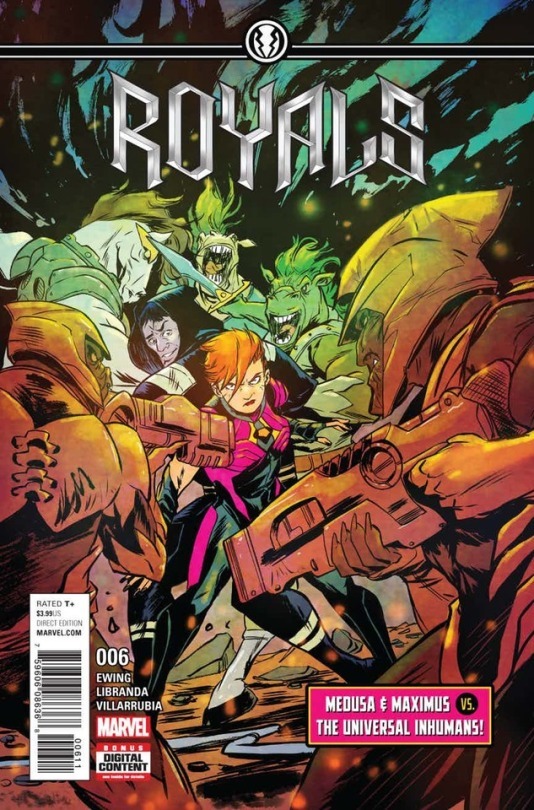
The Royals #6 Review
spoilers spoilers spoilers spoilers spoilers spoilers spoilers spoilers spoilers
The Universal Inhumans make their long-awaited return in the latest installment of The Royals. With new artist, Kevin Libranda, joining forces with writer, Al Ewing, and colorist, José Villarrubia. Brief recap and review following the jump.
This squad’s eventful journey to Hala has put The Royals on the track of the mysterious Progenitors and the cosmic beings’ connections to both The Sky Spears as well as the Prima Materia from which Terrigen is derived.
Last issue saw Not-Varr recreate the Supreme Intelligence by way of fusing its seed with the Plex Intelligence (a more benevolent and peace-loving version of the living computer that originated from his home dimension). This new hybrid intelligence will attempt to ultimately bring about a new version of the Kree home world of Hala, an improved version in which peace, harmony and interconnectivity is the ultimate goal of more fully actualized society... what Noh-Varr refers to as ‘Hala in The Highest.’
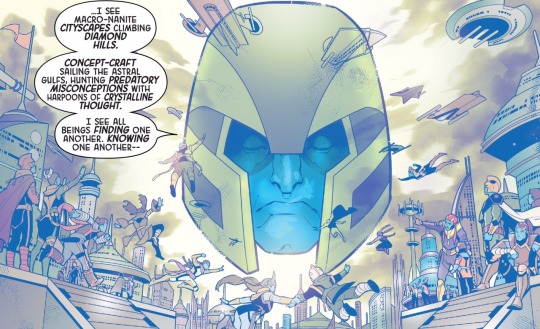
Ronan, the last surviver of Hala has accepted his role to guide the nascent new world on its path. Crystal, his one time wife and love, wishes to part on better terms, but Ronan is not yet ready to let go of his pain and heartbreak. It was duty that kept them apart to begin with and duty will once more stand between them. Whatever hopes Crystal might have had that their one time love might be replaced with friendship or at least a mutual fondness is dashed as Ronan sends her away to return to her family and the needs of her people that have always stood between them.
The Plex Intelligence has facilitated the repair of the Royals’ spacecraft, The Asterion, allowing the team to cruise off to their next destination in pursuit of the Sky Spears and the mysterious Progenitors.
They travel to the great city of Novahala on Centuri IV a new refuge where the remnants of the Universal Inhumans have established a new home base. It turns out that following the disbanding of the original Court of Universal Inhumnas, the four brides of the midnight king were not able to return to their respective homewolds; instead they have created a new home on Centuri IV where Inhumans of all races and species are welcome.
Medusa and the others are granted an audience with Medusa’s one-time sister wives and they are each rather displeased to hear of Black Bolt accidental banishment at the hands of his treacherous brother, Maximus.
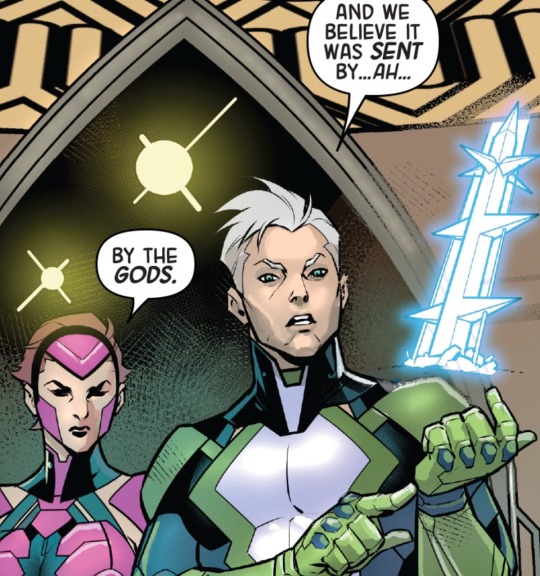
In an effort to appear the Queens, Medusa tells them of the Progenitors and the sky spears. It appears as though the Universal Inhumans are themselves familiar with these mysterious sky spears. Medusa and Not-Varr are asked to remain behind to discuss this matter while all others are told to leave (suggesting that some sensitive and secretive information is about to be discussed). Unfortunately, we will have to wait for later to find out what exactly they discuss as the narrative follows the dismissed Royals who are led out of the queens’ chambers by the Light Brigade.
Kal Blackbone, the Inhuman champion of Centuri takes Gorgon aside. As a fellow warrior, he can tell that his one time ally is troubled. Gorgon is initially reluctant to speak of this matter, but ultimately divulges that the chronic pain resulting from his past spinal injury has been getting worse and become more and more difficult to tolerate. Kal commiserates with Gorgon’s anguish and suggests the two drown their sorrows in ale whilst trading stories of past glory. The idea very much appeals to Gorgon, yet before he can follow Kal to the nearest bar, he is struck with an intense sense of pressure bearing down on him.
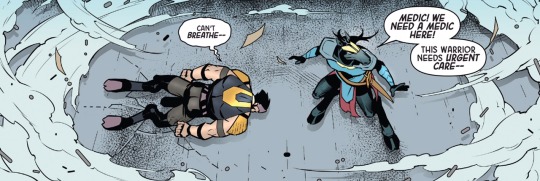
It initially looks as though he is having a heart attack, but it is quickly revealed as something much more sinister as the air around his body begins to swirl. Kal realizes that his friend is being attack by intruders and draws his blade to defend him. A blinding light fires forth and it appears as though Kal is disintegrated to ashes
The villains show themselves. They are warriors of the Snark race, the sworn enemies of the Centuri. These Snark warriors seem to possess the same powers as the one-time super team, The Power Pack. One has used a mastery over gravity to fell Gorgon while another has likely used laser powers to take out Kal.
The issue ends on a cliffhanger with the Snark warriors standing over a fallen Gorgons and declaring war in the name of their race.

An excellent issue. The Inhuman comics have finally really found their groove. All of the promise of a cosmic, spandex clad version of Game of Thrones has finally started coming to fruition as standard superhero fare has been traded in for intergalactic wars, alien diplomacy and intrigue and all sorts of cool, weird high-concept goings on.
With the exception of the rather shocking end scene, there wasn't a whole lot of action in the issue. Yet it is more than made up for by some really neat plot points, very cool world building, as well as some excellent character beats (especially for Crystal, Swain and Gorgon).
After Crystal’s harsh but fair dressing-down of Ronin in last month’s issue, it was nice to see her once more show her softer side in trying to make amends with her one time love. She has guanine affection for him and he for her, but Ronin is still far too emotionally wounded to be fully accept her ovations toward parting on friendlier terms. Although this is not to say that Ronan is left in some dismal place. The promise of Hala in The Highest will clearly reinvigorate Ronan and it is likely to be not too long before we see him once more in the role of a cosmic heavy in the Marvel Universe.
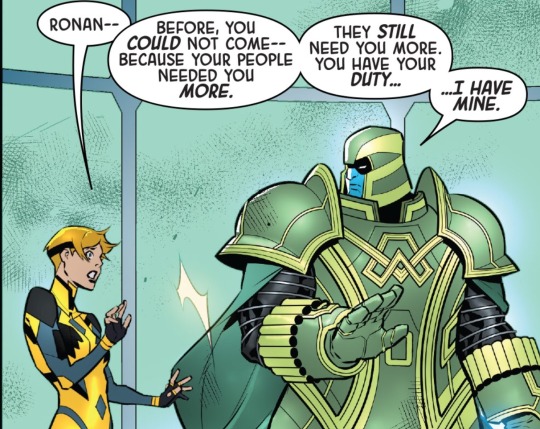
Maximus, with all his nasty patter, continues to be a very fun character to read. Yet, Ewing should be a bit careful about how he treads in regards to having Maximus mock Swain’s relationship with Panacea. Maximus’ insults are not that far off from the kind of bigotry that many among the autistic/neuroatypical community are often forces to contend with and it would be a needless shame were any of that community to come off as alienated by Maximus’s insults.
Speaking of Panacea, it does not appear as though her treatment of Gorgon’s injuries are proving as effective as initially seemed. It looks as though his chronic pain may be worsening, possibly a result of Pan’s ‘cure’ wearing off. Ewing has forewarned that a cast member will perish rather soon and I continue to be the most worried for Gorgon. I dashed through those last few pages quite frightened that it would show Gorgon dying. And even now his wellbeing is far from certain. Not to mention that I’m a bit heartbroken to see Kal apparently killed off. he was easily my favorite among the Light Brigade and always a fun character to read about. I’m hoping that it will be shown that he was only stunned rather than killed.
Novahala is a neat and welcome addition to the extended Inhuman mythos. I really dig the idea of a cosmic home base for the the various Universal Inhumans first introduced in J. Hickman’s run on Fantastic Four.
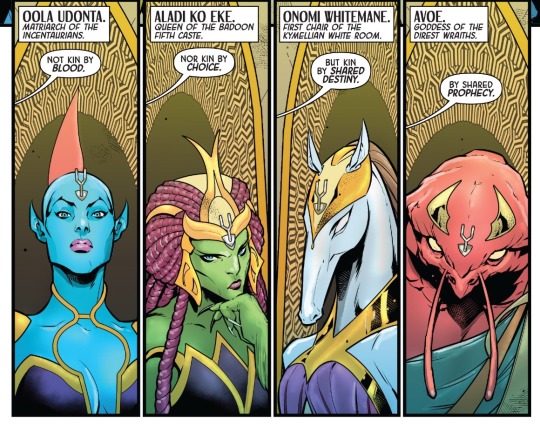
In lieu of a letters page, Ewing and company provided a very handy reference guide at the end of the issue, detailing the various throwbacks to older Inhuman and Kree involved tales that are peppered throughout the issue. It’s a rather helpful reference as well as good accounting of a number of stories and comics that are each highly recommended
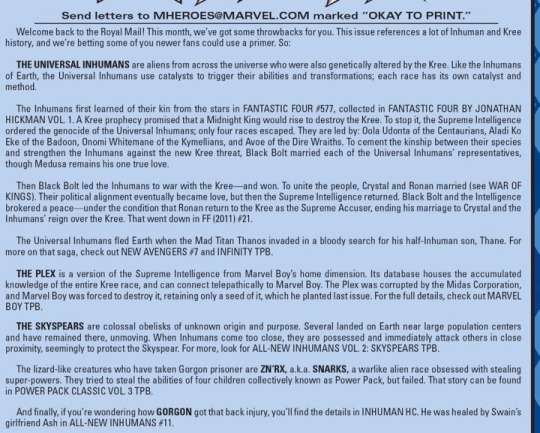
Kevin Libranda’s art is a welcome addition and works just wonderfully with the story. His clean and confident line-work is extremely effective at bringing to life the wild new environments. I also very much enjoy his knack for capturing emotion via facial features. Medusa’s desperate determination, Maximus’ snark and Crystal’s compassion are each very well reflected in the ways in which Libranda illustrates faces and body posture. It’s very impressive and works terrifically in conjunction with José Villarrubia’s vibrant coloring.
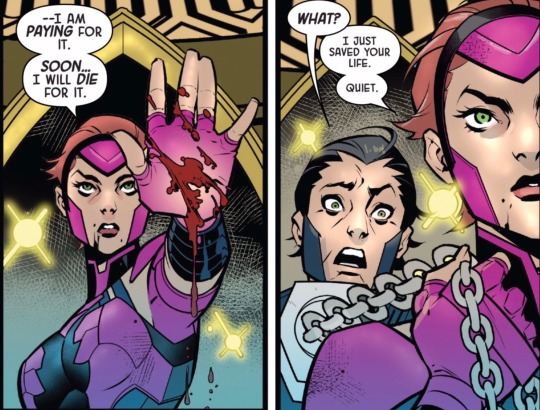
Definitely recommend; Four out of five Lockjaws!

7 notes
·
View notes
Text
Flame in the Mist

Ahhhh - it isn’t that great. I thought the whole time about Tales of The Otori by Lian Hearn and how much better those books are and the impression that Ahdieh was clearly inspired by Hearn doesn’t make it better.
Summary: Mariko, a samurai lady, is to marry an imperial prince but she dislikes the prospect. On her voyage to the capital, her group gets raided and she escapes. She thinks the Black Clan is responsible and decides to find out why she was attacked, to prove her worth apart from being a bride, as she sees herself rather as a scholar. She cross-dresses as a boy to find the Black Clan while her brother Kenshin searches for her. Meanwhile, the emperor makes plans for his two sons rule the empire together, with one as a monarch and one as a general.
All in all: I think it is very, very tropey and predictable. It isn’t exciting to read, and we see barely any worldbuilding and intrigue.
Flame in the Mist has 400 pages and hardly anything happens, yet Across The Nightingale Floor has not even 300 pages and like ten times as much plot. This is obviously my pet peeve, but I think this is really disappointing because Ahdieh has laid out a lot of characters and potential for a plot but she just doesn’t bother to introduce them and get started. The princes must be so interesting, like Cal and Maven, yet we hardly see them at all. The same with the emperor, or Mariko’s parents. Some flashbacks would have been really nice.
Why is the plot so weak?. A lot of pages are filled with banter and repetitions of plans/thoughts I’ve understood 20 pages prior. There’s just too much telling instead of showing or at least summarizing. I think this is a classical case of “I’m too old for this,” lol. Please Miss Ahdieh, get to the point. Mariko is terribly naive at some points but is always praised for her cleverness. The other characters, apart from my darling Kenshin and Okami, aren’t described very well. They banter instead of showing who they are. The plot twist at the end underdemines the agenda of the Black Clan a little: They want equality, yet they still cling to bloodlines and noble birth, how does that work? Apart from ronin/samurai wanting equality being historically extremely inaccurate. It’s not explained what the Black Clan is, for a long time (they’re not even called bandits), until we see that they’re supposed to be some kind of Robin Hood squad.
The books is a lot into descriptions and I like them to a large part. Though they are somewhat inaccurate because the book starts in late spring aka May and sakura blossoms are no longer blooming in May, couldn’t someone tell Ahdieh that? Or is it magic? Because there is magic in the book, but it isn’t explained either. Ahdieh wants the sakura aesthetic, but the beauty of sakura blossoms is that they are so short-lived, like two weeks in March/April. Then again, the descriptions sometimes fail to deliver the setting of the scene and the persons involved, especially in the prologue. I suppose that is intentional though I still don’t think the first sentences are optimal.
Another inaccuracy is the samurai philosophy. Mariko the protagonist says to some ronin that she cherishes freedom most of all. But that must sound offensive to a ronin. Samurai culture didn’t cherish freedom, it valued loyalty, obedience and servitude. In most cases, it was a disgrace to be a ronin without a lord and master, because it probably meant they had failed at some point.
Terrible epithets and their overuse. I get that Mariko not knowing people’s names is realistic and unsettling, but if I have to read “hissing vulture” four times on two pages, I start to wonder if it’s really a vulture and not a man. That chapter- the choice - is very weak in general because the pacing is awful. I couldn’t wait for Mariko to stop analyzing so the fighting could start.
I didn’t like the main ship when it starts to show, but when they get it on, they’re cute enough if I squint my eyes so I don’t start ranting. The other ship is more to my liking, but sadly, no lgbt+ couple around so far.
There are some very nice sentences about a disabled person, relatable feelings about bullying and some good arguments in regards to feminism.
Mariko marveled at the fluidity of his movements. His wooden limb did not hamper him. Nor did it grant him any advantage, in that heedless way of stories. It was not a gift, nor was it a blessing. It simply was. Just as he simply was.
She hated this feeling. The feeling of being vulnerable. Mocked. It was the first time in a long while she’d had to stand still and experience abject ridicule. It was true many people found her odd, but her family’s position and influence had spared her from being met head-on by the judgment of others. When she did hear it, it was at her back, whispered being lacquered fans or in the shadow of elegantly papered screens. (negative points for combining bullies and wealth/beauty though)
That same awful feeling of being mocked took hold of Mariko. Vicious, unrelenting hold. Making her feel so much smaller than those around her. So much less of everything when all she wished to fele was taller and stronger and braver. [...] Instead of letting the fear allow her to shrink into herself, Maroko let it feed her. It collected in her stomach. Twisting in her thoat. Reshaping inot anger.
But feminism isn’t handled that great here. Mariko is 100 % “not like other girls” and the author seems to be proud of it. And this is such a trope, but it becomes a really bad one in a historical setting. It’s not nice to shit on basically every women living in that period because unlike the protagonist with a 21th century mindset, they clinged to social norms and made the best of it. We have two other female POVs (each only one chapter) and both of them seem to be villains. Court women are disliked. (Hell, the Genji Monogatari was written a 1000 years ago and is the archetype of a soap opera about rich people and their love life, but that one managed not to shit on women and to include mindless girl-on-girl hate.) Arranged marriage is labelled as bad and called “selling”. I certainly don’t want to advocate arranged marriages, but if you choose to write in a historical setting, you have to look through the eyes of someone living at the time, and not like someone who time-travelled there. The arranged marriage for Mariko with an imperial prince sounds like the most promising and properous match for a young woman of her time and she should be aware and proud of that. Spoiler: And Mariko isn’t afraid of sex by default either. Basically, Mariko’s feminist statements sound like standards to be dropped and quoted to show that your protagonist is progressive and a strong woman. Not even her cross-dressing is handled well. Mariko binds her breasts (which isn’t recommended irl) and she never complains about it, not even when she goes bathing and can finally relax.
Positive point for showing Mariko’s father as conservative but still supporting his daughter deviating interests. Unfortunately, we hardly see who he really is, apart from some villifying of him at the end of the book.
Negative point for including sex without talking about contraception.
10 notes
·
View notes